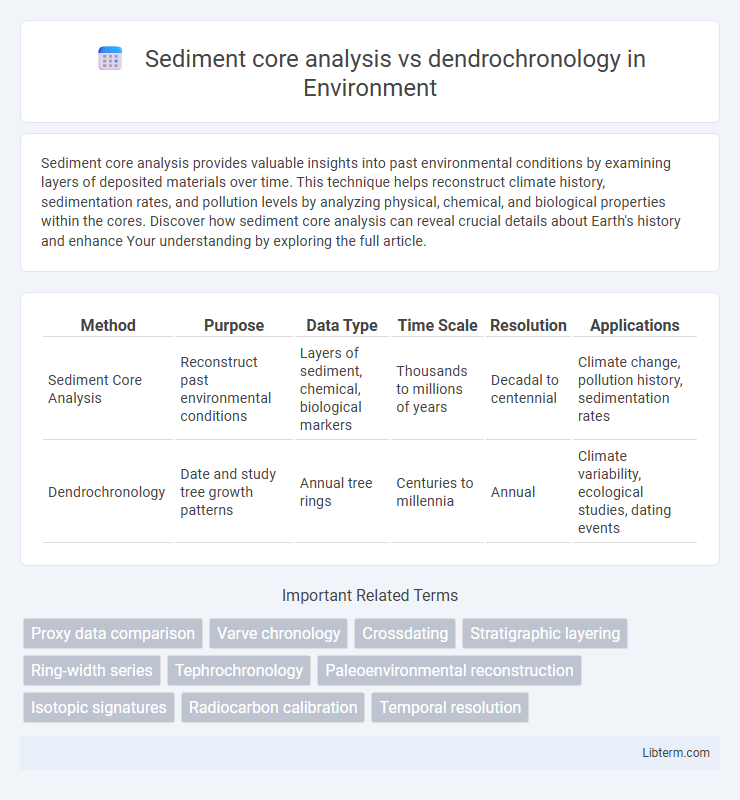Sediment core analysis provides valuable insights into past environmental conditions by examining layers of deposited materials over time. This technique helps reconstruct climate history, sedimentation rates, and pollution levels by analyzing physical, chemical, and biological properties within the cores. Discover how sediment core analysis can reveal crucial details about Earth's history and enhance Your understanding by exploring the full article.
Table of Comparison
| Method | Purpose | Data Type | Time Scale | Resolution | Applications |
|---|---|---|---|---|---|
| Sediment Core Analysis | Reconstruct past environmental conditions | Layers of sediment, chemical, biological markers | Thousands to millions of years | Decadal to centennial | Climate change, pollution history, sedimentation rates |
| Dendrochronology | Date and study tree growth patterns | Annual tree rings | Centuries to millennia | Annual | Climate variability, ecological studies, dating events |
Introduction to Sediment Core Analysis and Dendrochronology
Sediment core analysis involves examining layers of sediment deposited over time to reconstruct past environmental conditions, providing valuable data on climate change, volcanic activity, and human impact. Dendrochronology is the scientific method of dating tree rings to analyze annual growth patterns, which helps in understanding past climate variations and ecological changes. Both techniques offer critical insights into Earth's history but differ in temporal resolution and the type of data they yield.
Principles Behind Sediment Core Analysis
Sediment core analysis involves extracting cylindrical sections of sediment layers to study historical environmental changes preserved over time, with the principle based on stratigraphy and sediment deposition rates. This method analyzes physical, chemical, and biological properties within sediment layers to reconstruct past climates, pollution events, or ecological shifts. Unlike dendrochronology, which interprets annual tree ring patterns for dating, sediment core analysis provides a continuous, multi-proxy record spanning longer geological timescales.
Fundamentals of Dendrochronology
Dendrochronology is the scientific method of dating tree rings to analyze past environmental conditions and climate changes over time. It relies on the principle that each annual growth ring reflects specific climatic and ecological factors, providing precise chronological data for temporal analysis. Unlike sediment core analysis, which examines layered deposits in aquatic or soil environments, dendrochronology offers high-resolution, absolute dating based on biological growth patterns in trees.
Methods of Data Collection and Sampling
Sediment core analysis involves extracting cylindrical sections from lake or ocean floors using gravity or piston corers, capturing layered deposits that reveal chronological environmental changes and pollutant levels. Dendrochronology collects data by extracting tree ring samples with increment borers, allowing precise annual growth patterns to be studied for climate and ecological reconstructions. Sediment cores provide continuous multi-century records through stratigraphy, while dendrochronology offers high-resolution dating limited to the lifespan of the sampled trees.
Types of Environmental Records Captured
Sediment core analysis captures long-term environmental records by preserving layers of sediments that contain pollen, microfossils, and chemical signatures reflecting past climate, vegetation, and pollution changes over thousands to millions of years. Dendrochronology, or tree-ring analysis, provides high-resolution, annual data on climate variations, drought events, and ecological disturbances by examining growth patterns in tree rings. Together, these methods offer complementary insights into environmental history, with sediment cores revealing broad temporal scales and dendrochronology providing precise, year-by-year climate information.
Chronological Resolution and Timescales
Sediment core analysis provides a broad chronological resolution, often spanning thousands to millions of years, allowing the study of long-term environmental and climatic changes through layered deposits. Dendrochronology offers precise annual to seasonal resolution by examining tree ring patterns, making it ideal for reconstructing detailed climate records over centuries to millennia. While sediment cores capture extensive geological timescales, dendrochronology excels in fine-scale temporal analysis within shorter timescales.
Accuracy and Limitations of Both Techniques
Sediment core analysis provides accurate long-term environmental records by capturing layers of deposited materials that reflect historical climate, pollution, and ecological changes, but its resolution can be limited by bioturbation and dating uncertainties. Dendrochronology offers precise annual to seasonal dating through tree ring patterns, allowing detailed climate and growth condition reconstructions, though it is constrained by the lifespan and availability of suitable tree species. Both techniques face limitations in spatial coverage and require cross-validation with other proxies to enhance reliability and interpret complex historical data.
Applications in Climate Science
Sediment core analysis provides detailed records of past climate conditions by examining layered deposits, revealing information about ancient temperature, precipitation, and atmospheric composition changes over thousands to millions of years. Dendrochronology, or tree-ring dating, offers precise annual data on past climatic variations, such as droughts and temperature fluctuations, by studying growth rings in trees. Together, these methods enable comprehensive reconstruction of historical climate patterns, improving predictions of future climate change impacts.
Case Studies: Comparing Research Outcomes
Sediment core analysis reveals long-term environmental changes by examining layered deposits, while dendrochronology provides precise annual records through tree ring patterns; case studies highlight sediment cores' strength in capturing millennia-scale climate variations, contrasting dendrochronology's accuracy in dating recent decades. Research outcomes show sediment cores excel in tracing shifts in vegetation, erosion, and hydrology over thousands of years, whereas dendrochronology effectively reconstructs short-term droughts and temperature fluctuations. Combining both methods in comparative studies enriches understanding by correlating sedimentary data with high-resolution tree ring chronologies, improving climate reconstructions and ecosystem assessments.
Future Trends and Innovations in Paleoenvironmental Analysis
Sediment core analysis is advancing with high-resolution imaging and geochemical fingerprinting, enabling precise reconstruction of past climate conditions and pollutant histories. Dendrochronology benefits from integrating isotopic analysis and machine learning to enhance tree-ring pattern interpretation and extend chronologies into previously inaccessible regions. Future trends emphasize combining multi-proxy datasets from both methods to improve paleoenvironmental models and predict climate variability with greater accuracy.
Sediment core analysis Infographic

 libterm.com
libterm.com